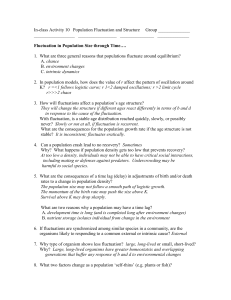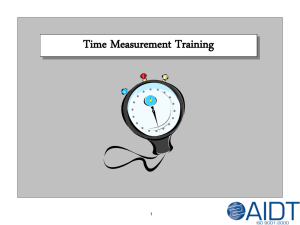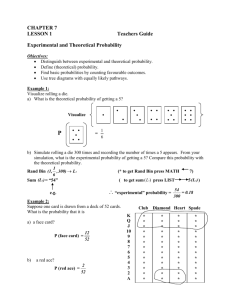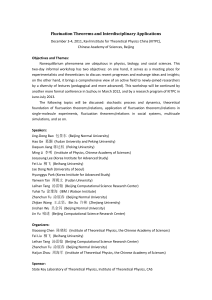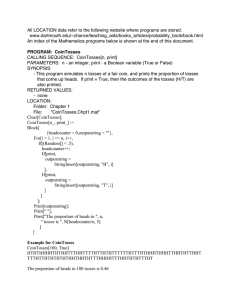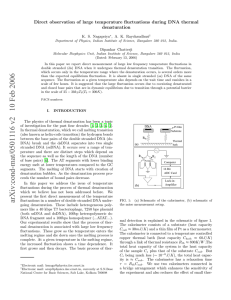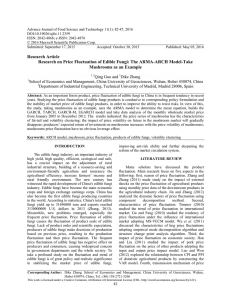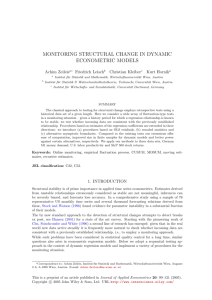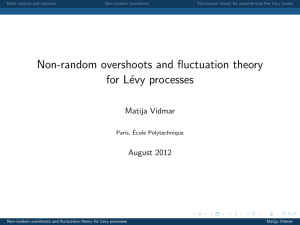Discontinuous Patterns During Psychotherapy of
advertisement
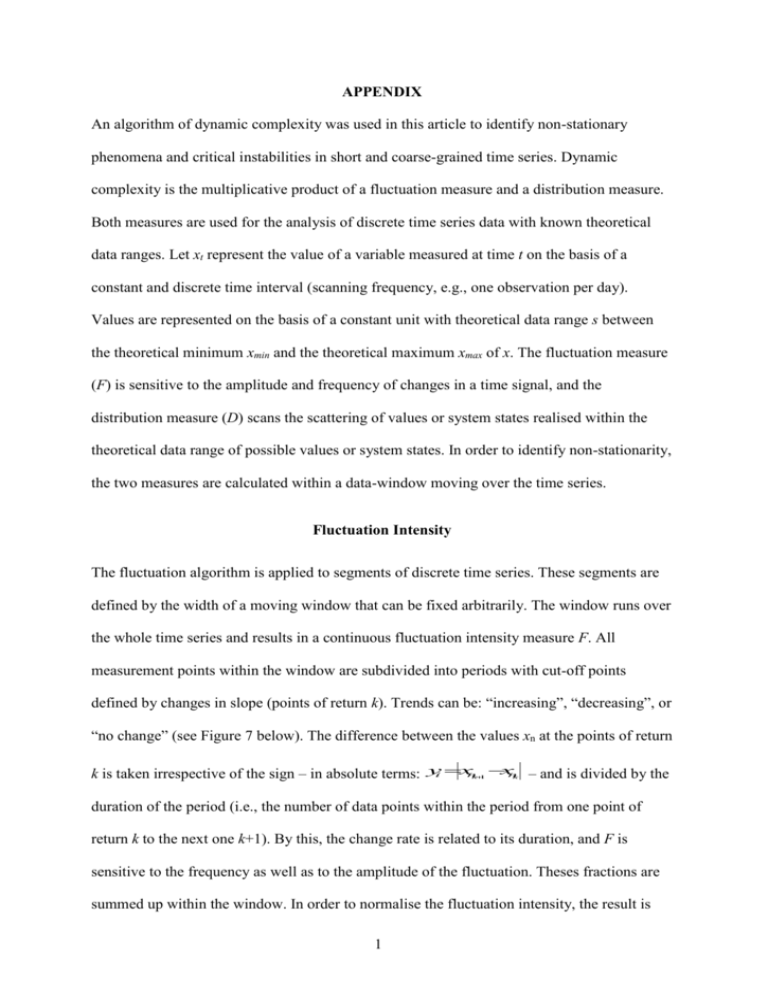
APPENDIX
An algorithm of dynamic complexity was used in this article to identify non-stationary
phenomena and critical instabilities in short and coarse-grained time series. Dynamic
complexity is the multiplicative product of a fluctuation measure and a distribution measure.
Both measures are used for the analysis of discrete time series data with known theoretical
data ranges. Let xt represent the value of a variable measured at time t on the basis of a
constant and discrete time interval (scanning frequency, e.g., one observation per day).
Values are represented on the basis of a constant unit with theoretical data range s between
the theoretical minimum xmin and the theoretical maximum xmax of x. The fluctuation measure
(F) is sensitive to the amplitude and frequency of changes in a time signal, and the
distribution measure (D) scans the scattering of values or system states realised within the
theoretical data range of possible values or system states. In order to identify non-stationarity,
the two measures are calculated within a data-window moving over the time series.
Fluctuation Intensity
The fluctuation algorithm is applied to segments of discrete time series. These segments are
defined by the width of a moving window that can be fixed arbitrarily. The window runs over
the whole time series and results in a continuous fluctuation intensity measure F. All
measurement points within the window are subdivided into periods with cut-off points
defined by changes in slope (points of return k). Trends can be: “increasing”, “decreasing”, or
“no change” (see Figure 7 below). The difference between the values xn at the points of return
k is taken irrespective of the sign – in absolute terms: yi xn xn – and is divided by the
k
1
k
duration of the period (i.e., the number of data points within the period from one point of
return k to the next one k+1). By this, the change rate is related to its duration, and F is
sensitive to the frequency as well as to the amplitude of the fluctuation. Theses fractions are
summed up within the window. In order to normalise the fluctuation intensity, the result is
1
related to the greatest possible fluctuation which is given by the maximum amount of change
within a minimum duration. This is the sum of the differences between the lowest and the
highest value of the available range between one and the next measurement point. The
formula results in normalised fluctuation intensity 0 ≤ F ≤ 1:
I
(1)
yi
n )
F i1 k1 k
s(m1
)
(n
with
y
x
i x
n
n
k
1
k
xn
nth value of the time series
k
points of return (number of changes in slope of the data sequence)
i
periods between points of return
I
total number of such periods within the window
m
number of measurement points within a moving window
m–1
number of intervals between all measurement points of a window
s = xmax - xmin
with xmin smallest value of the scale, xmax largest value of the scale.
I
y
i
s
(
m
1
), so 0 ≤ F ≤ 1, see Figure 7.
One can immediately derive that
n
n
i
1 k
1
k
Note that s(m-1) is the window area expressed in units of t and x and that s is not the
empirical data range but the theoretical range of the scale.
2
Figure 7: Illustration of the fluctuation algorithm. In this example, the F-value is
calculated as follows: The first contributor is between k=1 and k=2 a difference of 3 (since x1
= 3, x3 = 6), divided by 2 (2 is the number of intervals between k=1 and k=2). The next
contributor is between k=2 and k=3 a difference of 3, divided by only one interval. Next is a
difference of 0 divided by 2 intervals (remains 0) and the last difference between k=4 and k=5
is 4, divided by 1. So we sum up 3/2 + 3/1 + 0/2 + 4/1 = 8.5. This sum is divided by the
maximum of possible fluctuation, which in this case is (with the greatest number of points of
return) k = 1 to k = 7, and s = (xmax – xmin) = 7 – 1 = 6): 6/1 + 6/1 + 6/1+ 6/1 + 6/1 + 6/1 = 36.
F = 8.5/36 = .23611.
k =1
xmax 7 –
k =4 k =5
k =2 k =3
6 –
5 –
4 –
y1 = 3
y2 = 3
3 –
y3 = 0
y4 = 4
2 –
2
i =1
xmin 1 –
1
i =2
2
i =3
1
i =4
m= 7
n=
|
1
|
2
|
|
3
4
|
5
|
6
|
7
|
8
|
9
Distribution
The degree of distribution D represents another aspect of critical instabilities. Whereas F is at
its maximum when the dynamics jump between the minimum and maximum values with
greatest and equal frequency, instabilities are often characterised by irregularities, resulting in
quite different system states. In the extreme case, the values should be irregularly and
chaotically distributed across the range of the measurement scale. As a result, the degree of
distribution measures the deviance of the values from an ideal equal distribution of the values
across the range or measurement scale. As for the calculation of F, we used a moving
3
window running through the whole process and by doing this we consider the values over the
full course of the process. For the distribution measure the order of values within the moving
window is irrelevant, and in a first step values are sorted in ascending order. Let xi be the
values of a variable x at the sorting position i within the ≤moving window X which is given
by:
X = {x1, x2, x3, ... xm} with x1 ≤ x2 ≤ x3 ≤ ... xm
In the following calculation this sorted window is compared with an artificial data set of
equally distributed values. This artificial data set consists of the same number m of values
arranged in ascending order in equally spaced intervals between the theoretical scale
minimum and maximum. The interval I is given by I=s / (m-1), s = xmax - xmin and the
artificial data set Y is given by:
Y = {y1=I*1, y2=I*2, y3=I*3, ... ym=I*m}
If the data set in X is equally distributed within the data range, then differences between
values at different positions in X must be equal to the differences in Y at the same positions.
To give an example, if X is perfectly equally distributed within the data range, then δY.2-1 = y2y1 = δX.2-1 = x2-x1. Generally the aberration Δba of X from the ideal given in Y can be
calculated for the positions a and b as follows:
Δba= δY.b-a – δX.b-a with δY.b-a = yb-ya and δX.b-a = xb-xa
In total the aberration Δ* is given by the following permutation of a and b.
m
1
m
d
1
d
Δ* =
(
)
ba
ba
c
1
d
c
1
a
c
b
a
1
The two outer sums are permutations of all combinations of c and d within the window. The
inner sums of a and b are representing all combinations of positions within the interval given
by c and d.
4
(Δba) is the Heaviside step function resulting in 1 if Δba is a positive number; otherwise the
function results in 0. Therefore, only positive aberrations are considered, because negative
aberrations have the consequence of resulting in positive ones in other positions.
Hence, the distribution measurement D is given by:
m
1
m
d
1
d
(2)
D=1–
(
)
ba
ba
Y
.
ba
c
1
d
c
1
a
c
b
a
1
One can see that D is normalized so that 0 ≤ D ≤ 1, and a high value of D are the result of
equally distributed measures of x within the moving window.
5

